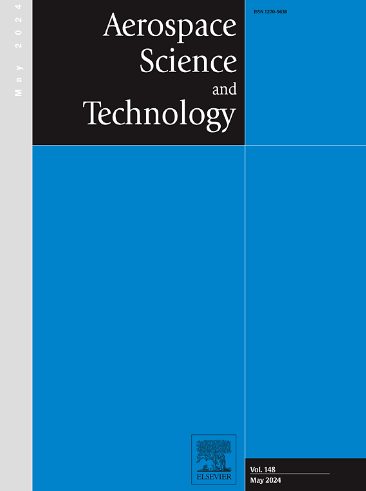由表面电弧等离子体驱动控制的冲击波和全湍流边界层相互作用
IF 5
1区 工程技术
Q1 ENGINEERING, AEROSPACE
引用次数: 0
摘要
实验研究了表面电弧等离子体致动器对超音速气流中 26 度斜坡上完全湍流边界层相互作用的控制效果。实验采用了非侵入式离层仪和综合统计处理技术。为实现可视化,进行了高达 25 kHz 的时间分辨离层测量。对裂隙数据集进行了均方根(RMS)、快速傅里叶变换(FFT)和适当正交分解(POD),以识别相互作用流中的结构。在位于斜坡上游的一对电极之间产生放电,以引起湍流边界层的显著扰动。放电频率分别为 fa=0.5、1、2 和 5 kHz。研究结果表明,较低的激励频率会给流场带来更大的瞬时能量输入,而随着时间的推移,5 kHz 时的累积能量最高。分离区域的抑制效应通过裂隙强度的有效值得到了进一步验证。分离冲击的减弱通过 Schlieren 强度的 FFT 得到验证。结果表明,完全湍流边界层相互作用流模式的扰动对分离冲击控制和分离区域抑制更有效。重要的是要适当提高致动频率,以便对重新附着冲击实现一定程度的控制。这种控制效果取决于注入流场的总能量,而不是单个脉冲的大能量。本文章由计算机程序翻译,如有差异,请以英文原文为准。
Shock wave and fully turbulent boundary layer interaction controlled by surface arc plasma actuation
Experiments were performed to examine the control effect of surface arc plasma actuators on a fully turbulent boundary layer interaction over a 26-deg ramp in a supersonic flow. The experiments utilized a non-invasive schlieren measurement device, along with comprehensive statistical processing techniques. Time-resolved schlieren up to 25 kHz were performed for visualization. Root Mean Square (RMS), Fast Fourier Transformation (FFT), and Proper Orthogonal Decomposition (POD) were performed on the schlieren dataset for structure identification in the interaction flow. A discharge is created between an electrode pair located upstream of a ramp to induce significant disturbances in the turbulent boundary layer. The discharge frequencies employed are fa=0.5, 1, 2, and 5 kHz. The findings indicate that lower excitation frequencies result in a greater instantaneous energy input to the flow field, while the highest cumulative energy is obtained at 5 kHz over time. The separation region inhibited effect is further verified through the RMS of the schlieren intensity. The separation shock weaken is verified through the FFT of the schlieren intensity. The results indicate that perturbations in the fully turbulent boundary layer interaction flow pattern are more effective for separation shock control and separation region inhibition. It is important to appropriately increase the actuation frequency in order to achieve a certain level of control over the reattachment shock. This control effect is dependent on the total energy injected into the flow field rather than a large energy of a single pulse.
求助全文
通过发布文献求助,成功后即可免费获取论文全文。
去求助
来源期刊

Aerospace Science and Technology
工程技术-工程:宇航
CiteScore
10.30
自引率
28.60%
发文量
654
审稿时长
54 days
期刊介绍:
Aerospace Science and Technology publishes articles of outstanding scientific quality. Each article is reviewed by two referees. The journal welcomes papers from a wide range of countries. This journal publishes original papers, review articles and short communications related to all fields of aerospace research, fundamental and applied, potential applications of which are clearly related to:
• The design and the manufacture of aircraft, helicopters, missiles, launchers and satellites
• The control of their environment
• The study of various systems they are involved in, as supports or as targets.
Authors are invited to submit papers on new advances in the following topics to aerospace applications:
• Fluid dynamics
• Energetics and propulsion
• Materials and structures
• Flight mechanics
• Navigation, guidance and control
• Acoustics
• Optics
• Electromagnetism and radar
• Signal and image processing
• Information processing
• Data fusion
• Decision aid
• Human behaviour
• Robotics and intelligent systems
• Complex system engineering.
Etc.
 求助内容:
求助内容: 应助结果提醒方式:
应助结果提醒方式:


